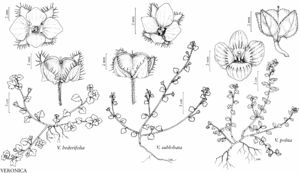Veronica hederifolia
Sp. Pl. 1: 13. 1753. (as hederaefolia)
Annuals. Stems decumbent to ascending, 5–40(–50) cm, eglandular-hairy. Leaves: blade suborbiculate, (3–)5-lobed, central lobe usually overtopping lateral ones, (5–)7–15(–20) × 8–16(–25) mm, base truncate, margins (3–)5-lobed, apex acute, surfaces sparsely eglandular-hairy. Racemes 1–10, terminal, 50–400(–500) mm, 5–20-flowered, axis eglandular-hairy; bracts suborbiculate, (3–)5-lobed, central lobe usually overtopping lateral ones, (5–)7–15(–20) mm. Pedicels patent or deflexed, (5–)9–15(–20) mm, equal to or ± shorter than subtending bract, length 2–3 times calyx, eglandular-hairy (in single line adaxially). Flowers: calyx lobes 5–6(–7) mm, apex acute, abaxial surface usually glabrous, ciliate with 25–35 hairs per side; corolla bright blue with bright white center, 5–7(–9) mm diam.; stamens sky blue, 0.7–1.2 mm; style (0.6–)0.7–0.9(–1.1) mm. Capsules ± round in cross section, ovoid, 3–4 × 4.5–6 mm, apex ± emarginate, glabrate. Seeds 1–4, bright yellow, ellipsoid to subglobular, urn-shaped, 2.3–3.3 × 2–3 mm, 1–2.2 mm thick, weakly cristate or rugose, ± smooth. 2n = 54 (Eurasia).
Phenology: Flowering (Feb–)Mar–Jun.
Habitat: Fields, lawns, gardens, ruderal places, vineyards, open forests, shady rocky places, dunes.
Elevation: 0–2000 m.
Distribution
Introduced; B.C., Ont., Ala., Ark., Calif., Conn., Del., D.C., Fla., Ga., Ill., Ind., Kans., Ky., La., Md., Mich., Mo., Nebr., N.J., N.Y., N.C., Ohio, Okla., Oreg., Pa., S.C., S.Dak., Tenn., Utah, Va., Wash., W.Va., Eurasia.
Discussion
Selected References
None.
